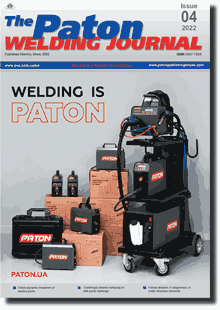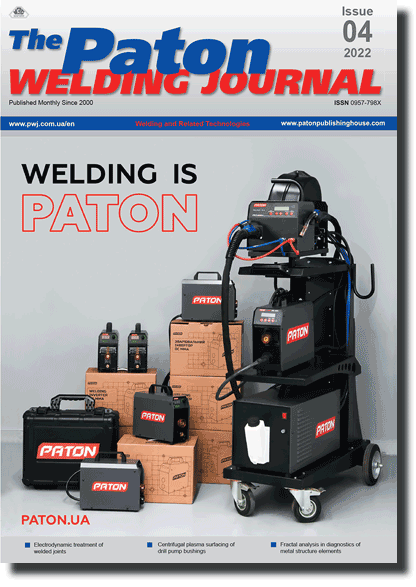| 2022 №04 (03) |
DOI of Article 10.37434/tpwj2022.04.04 |
2022 №04 (05) |

The Paton Welding Journal, 2022, #4, 19-25 pages
Fibre laser welding of aluminium alloys of 7xxx series (Al–Zn–Mg–Cu) by nonthrough thickness welds
V.M. Korzhyk1, V.Yu. Khaskin1, A.A. Grynyuk2, S.I. Peleshenko3, Yao Yuhui4, S.G. Hryhorenko2, V.O. Shcheretskiy2, O.S. Kushnarova2
1China-Ukraine Institute of Welding, Guangdong Academy of Sciences, Guangdong Provincial Key Laboratory of Advanced Welding Technology, Guangzhou, 510650, China. E-mail: patonjournal@gwi.gd.cn
2E.O. Paton Electric Welding Institute of the NASU. 11 Kazymyr Malevych Str., 03150, Kyiv, Ukraine. E-mail: vnkorzhyk@gmail.com
3NTUU «Igor Sikorskiy Kyiv Polytechnic Institute». 37 Peremohi Prosp., 03056, Kyiv. E-mail: imz.paton.kpi@gmail.com
4Shenzhen Hanzhizi Technology Co., Ltd. 6th Floor, Building B, Bantian International Center, 5 Huancheng South Road, Longgang District, Shenzhen, Guangdong, China, E-mail: 514929948@qq.com
Abstract
The paper deals with the features of laser welding with incomplete (non-through thickness) penetration of high-strength aluminium alloys of 7ххх series. It was found that at joining of 1.5 mm sheets by fibre laser welding to the depth of 0.5…0.7 mm there arises the risk of formation of pores, in particular, in the root zone, streaks of oxide film in the weld lower part, as well as hot cracks. The latter can be eliminated by reducing the heat input below 25 – 30 J/mm. The weld metal is characterized by an equiaxed finely dispersed structure with grain size of 10…15 ~m for 7005 alloy and 15…25 ~m for 7075 alloy. In the fusion zone, the grains are of an elongated shape with 2.5…3.0 coefficient for 7005 alloy and 2…5 for 7075 alloy. In the HAZ the grain length is reduced, the shape coefficient becomes 3…5 and 3.0…3.5 for 7005 and 7075 alloys, respectively. At performance of laser welding with small (~5 J/mm) values of the heat input, microhardness of the welds and HAZ is rather uniform, and close to that of the base metal. For 7075 alloy microhardness drop to 20% was observed in the fusion zone region, that is due to formation of grains of an elongated shape with shape coefficient of 2…5. The found drawbacks can be eliminated through reduction of pulsations of the vapour-gas channel with simultaneous increase of the stability of its existence and introduction of cathode breaking of the oxide film. 11 Ref., 4 Tabl., 8. Fig.
Keywords: aluminium alloys of 7ххх series, laser welding, weld formation, graininess, defects, ways to eliminate
Received: 28.03.2022
Accepted: 30.06.2022
References
1. Varshney, D., Kumar, K. (2021) Application and use of different aluminium alloys with respect to workability, strength and welding parameter optimization. Ain Shams Engineering Journal, 12, 1, 1143-1152. https://doi.org/10.1016/j.asej.2020.05.0132. Kang, M., Kim, C. (2017) A Review of Joining Processes for High Strength 7xxx Series Aluminum Alloys. Journal of Welding and Joining, 35, 6, 79-88. https://doi.org/10.5781/JWJ.2017.35.6.12
3. Löveborn, D., Larsson, J. K., Persson, K.-A. (2017) Weldability of Aluminium Alloys for Automotive Applications. Physics Procedia, 89, 89-99. https://doi.org/10.1016/j.phpro.2017.08.011
4. Kang, M., Cheon, J., Kam, D.-H., Kim, C. (2021) The hot cracking susceptibility subjected the laser beam oscillation welding on 6XXX aluminum alloy with a partial penetration joint. Journal of Laser Applications, 33, 012032. https://doi.org/10.2351/7.0000319
5. Kim, C.-H., Ahn, Y.-N., Lim, H.-S. (2011) Laser Welding of Automotive Aluminum Alloys. Journal of Welding and Joining, 29, 4, 21-26. https://doi.org/10.5781/KWJS.2011.29.4.383
6. Zhao, H., White, D.R., DebRoy, T. (1999) Current issues and problems in laser welding of automotive aluminium alloys. International Materials Reviews, 44, 6, 238-266. https://doi.org/10.1179/095066099101528298
7. Korzhyk, V., Khaskin, V., Grynyuk, A. et al. (2022) Comparison of the features of the formation of joints of aluminum alloy 7075 (Al-Zn-Mg-Cu) by laser, microplasma, and laser-microplasma welding. Eastern-European Journal of Enterprise Technologies, 1/12(115), 38-47. https://doi.org/10.15587/1729-4061.2022.253378
8. Holzer, M., Hofmann, K., Mann, V. et al. (2016) Change of Hot Cracking Susceptibility in Welding of High Strength Aluminum Alloy AA 7075. Physics Procedia, 83, 463-471. https://doi.org/10.1016/j.phpro.2016.08.048
9. Fetzer, F. (2018) Fundamental investigations on the spiking mechanism by means of laser beam welding of ice. Journal of Laser Applications, 30, 1, 012009-1-012009-9. https://doi.org/10.2351/1.4986641
10. Shelyagin, V.D., Khaskin, V.Yu., Garashchuk, V.P. et al. (2002). Hybrid CO2-laser and CO2 consumable-arc welding. The Paton Welding J., 10, 35-38.
11. Krivtsun, I.V., Shelyagin, V.D., Khaskin, V.Yu. et al. (2007) Hybrid laser-plasma welding of aluminium alloys. Ibid, 5, 36-40.
Suggested Citation
V.M. Korzhyk, V.Yu. Khaskin, A.A. Grynyuk, S.I. Peleshenko, Yao Yuhui, S.G. Hryhorenko, V.O. Shcheretskiy, O.S. Kushnarova (2022) Fibre laser welding of aluminium alloys of 7xxx series (Al–Zn–Mg–Cu) by nonthrough thickness welds. The Paton Welding J., 04, 19-25.The cost of subscription/purchase order journals or individual articles
| Journal/Currency | Annual Set | 1 issue printed |
1 issue |
one article |
| TPWJ/USD | 384 $ | 32 $ | 26 $ | 13 $ |
| TPWJ/EUR | 348 € | 29 € | 24 € | 12 € |
| TPWJ/UAH | 7200 UAH | 600 UAH | 600 UAH | 280 UAH |
| AS/UAH | 1800 UAH | 300 UAH | 300 UAH | 150 UAH |
| AS/USD | 192 $ | 32 $ | 26 $ | 13 $ |
| AS/EUR | 180 € | 30 € | 25 € | 12 € |
| SEM/UAH | 1200 UAH | 300 UAH | 300 UAH | 150 UAH |
| SEM/USD | 128 $ | 32 $ | 26 $ | 13 $ |
| SEM/EUR | 120 € | 30 € | 25 € | 12 € |
| TDNK/UAH | 1200 UAH | 300 UAH | 300 UAH | 150 UAH |
| TDNK/USD | 128 $ | 32 $ | 26 $ | 13 $ |
| TDNK/EUR | 120 € | 30 € | 25 € | 15 € |
AS = «Automatic Welding» - 6 issues per year;
TPWJ = «PATON WELDING JOURNAL» - 12 issues per year;
SEM = «Electrometallurgy Today» - 4 issues per year;
TDNK = «Technical Diagnostics and Non-Destructive Testing» - 4 issues per year.


